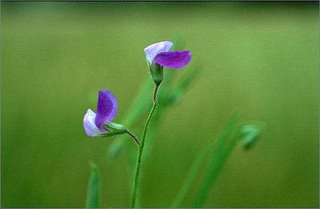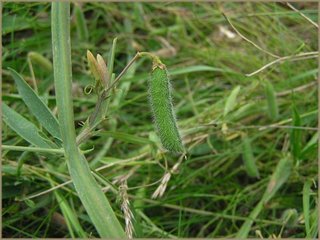
Today in the French Republican calendar is Messidor 18 and the plant of the day is the Gesse or Hairy Vetchling. In my quest to find a way to share my love of fllower folklore with others, I’ve thought of many methods of presentation, and one is the idea of a book of Birthday Flowers. But who wants to be born on the day of the Hairy Vetchling (as a blogger whose blog I ran across while googling hairy vetchling so poignantly asks)?
The hairy vetchling seems to be a rare wild relative of the garden Sweet Pea. It seems to be much appreciated and sought after in England (I’m not sure it exists in North America). Ralph Hollins in his Nature Diary (http://www.havnn.net/Diary.htm), describes it in an entry for June 16:
"The plant is a scrambler with very distinctive pairs of erect leaves looking somewhat like Hare’s ears, and with very long stalked flowers (two or three on each stem). The leaves are about 5 or 6 cms long but narrow and folded so that the sides almost meet above the central vein (or ‘keel’). The flowers are similar in size to those of Grass Vetchling but are distinctively two tone in colour with a reddish-purple standard and creamy wings and keel. "
Other common names for the hairy vetchling include Austrian winterpea, caley pea and singletary pea. According to the American Heritage Dictionary, the name vetch comes from the same root word as weak and wicker, and refers to the pliable, twining nature of the plant. Its Latin name Lathyrus, which applies to all members of the pea family, comes from an Akkadian word ladiru, which refers to a certain type of plant (presumably the pea). That’s a great pedigree.
Vetch has been grown as a food and forage crop for centuries in the Mediterranean and India, although some species (and hairy vetchling appears to be one) have a neurotoxin in their seeds which can cause paralysis in humans with heavy consumption.

The hairy vetchling reminds me a bit in looks of some of the wild sweet peas that grow in my neighborhood which are just now beginning to put forth their seed pods. I will take a closer look at them today on my way to work to see if they are hairy. According to my Northwest Weeds book, they are probably a naturalized sweet pea (lathyrus tingitanus) rather than the hairy vetchling.
The best known member of the lathyrus family is lathyrus odoratus (the sweet pea). They are just now beginning to bloom in my garden and I have some lovely old-fashioned, fragrant ones that are purple and pink. My Irish great-great-grandmother, Bridget Banks Fitzgerald, was famous for her sweet peas which grew along the fence all the way down the drive to the farmhouse in Hartland, Minnesota. I like to say that I grow my sweet peas in memory of her. They are also the quintessential summer solstice flower for me as we have used them to mark the edges of our circle for years of summer solstice bonfires at Golden Gardens.
If you can't find a hairy vetchling, or its close relative, in your neighborhood, find some sweet peas instead.
References:
Martin, Laura C., Garden Flower Folklore, Globe Pequot Press 1987
Taylor, Ronald J, Northwest Weeds, Mountain Press Publishing Company 1990
Photographs:
Of hairy vetchling flower
http://www.dijon.inra.fr/hyppa/hyppa-a/lthhi_ah.htm#Adult plant
Of hairy vetchling seed pod
http://www.s-weeds.net/familjer/rosales/fabaceae/lathhirs.html
1 comment:
Like the old saying 'beauty is only skindeep', perhaps names are only skindeep too... I certainly wouldn't mind being born under such a flower...
Post a Comment